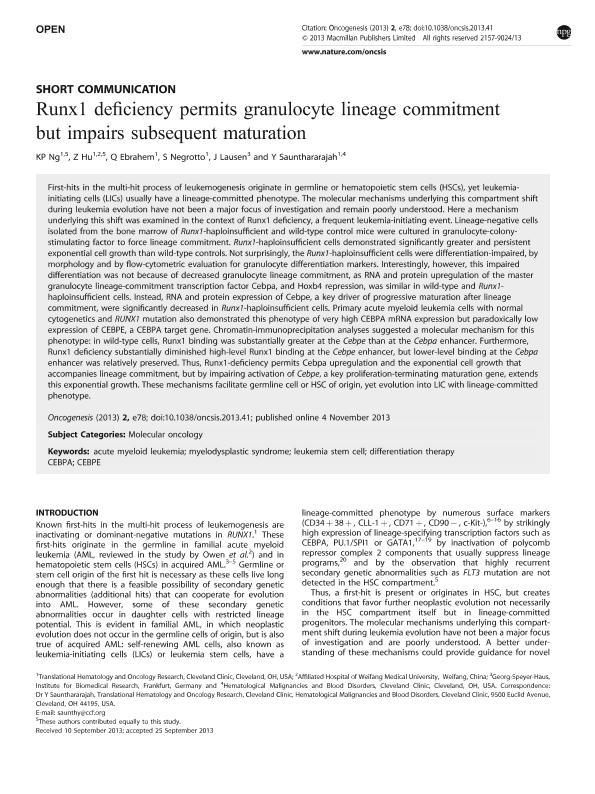Mostrar el registro sencillo del ítem
dc.contributor.author
Ng, K. P.
dc.contributor.author
Hu, Z.
dc.contributor.author
Ebrahem, Q.
dc.contributor.author
Negrotto, Soledad

dc.contributor.author
Lausen, J.
dc.contributor.author
Saunthararajah, Y.
dc.date.available
2017-11-27T22:42:53Z
dc.date.issued
2013-11
dc.identifier.citation
Ng, K. P.; Hu, Z.; Ebrahem, Q.; Negrotto, Soledad; Lausen, J.; et al.; Runx1 deficiency permits granulocyte lineage commitment but impairs subsequent maturation; Nature Publishing Group; Oncogenesis; 2; 11; 11-2013; e78
dc.identifier.issn
2157-9024
dc.identifier.uri
http://hdl.handle.net/11336/29188
dc.description.abstract
First-hits in the multi-hit process of leukemogenesis originate in germline or hematopoietic stem cells (HSCs), yet leukemia-initiating cells (LICs) usually have a lineage-committed phenotype. The molecular mechanisms underlying this compartment shift during leukemia evolution have not been a major focus of investigation and remain poorly understood. Here a mechanism underlying this shift was examined in the context of Runx1 deficiency, a frequent leukemia-initiating event. Lineage-negative cells isolated from the bone marrow of Runx1-haploinsufficient and wild-type control mice were cultured in granulocyte-colony-stimulating factor to force lineage commitment. Runx1-haploinsufficient cells demonstrated significantly greater and persistent exponential cell growth than wild-type controls. Not surprisingly, the Runx1-haploinsufficient cells were differentiation-impaired, by morphology and by flow-cytometric evaluation for granulocyte differentiation markers. Interestingly, however, this impaired differentiation was not because of decreased granulocyte lineage commitment, as RNA and protein upregulation of the master granulocyte lineage-commitment transcription factor Cebpa, and Hoxb4 repression, was similar in wild-type and Runx1-haploinsufficient cells. Instead, RNA and protein expression of Cebpe, a key driver of progressive maturation after lineage commitment, were significantly decreased in Runx1-haploinsufficient cells. Primary acute myeloid leukemia cells with normal cytogenetics and RUNX1 mutation also demonstrated this phenotype of very high CEBPA mRNA expression but paradoxically low expression of CEBPE, a CEBPA target gene. Chromatin-immunoprecipitation analyses suggested a molecular mechanism for this phenotype: in wild-type cells, Runx1 binding was substantially greater at the Cebpe than at the Cebpa enhancer. Furthermore, Runx1 deficiency substantially diminished high-level Runx1 binding at the Cebpe enhancer, but lower-level binding at the Cebpa enhancer was relatively preserved. Thus, Runx1-deficiency permits Cebpa upregulation and the exponential cell growth that accompanies lineage commitment, but by impairing activation of Cebpe, a key proliferation-terminating maturation gene, extends this exponential growth. These mechanisms facilitate germline cell or HSC of origin, yet evolution into LIC with lineage-committed phenotype.
dc.format
application/pdf
dc.language.iso
eng
dc.publisher
Nature Publishing Group

dc.rights
info:eu-repo/semantics/openAccess
dc.rights.uri
https://creativecommons.org/licenses/by-nc-nd/2.5/ar/
dc.subject
Runx1
dc.subject
Hematopoietic Stem Cell
dc.subject
Leukemia Stem Cell
dc.subject
Granulocyte Maturation
dc.subject
Acute Myeloid Leukemia
dc.subject
Myelodysplastic Syndrome
dc.subject
Differentiation Therapy
dc.subject
Cebpa
dc.subject
Cebpe
dc.subject.classification
Inmunología

dc.subject.classification
Medicina Básica

dc.subject.classification
CIENCIAS MÉDICAS Y DE LA SALUD

dc.title
Runx1 deficiency permits granulocyte lineage commitment but impairs subsequent maturation
dc.type
info:eu-repo/semantics/article
dc.type
info:ar-repo/semantics/artículo
dc.type
info:eu-repo/semantics/publishedVersion
dc.date.updated
2017-07-17T21:14:29Z
dc.journal.volume
2
dc.journal.number
11
dc.journal.pagination
e78
dc.journal.pais
Reino Unido

dc.journal.ciudad
Londres
dc.description.fil
Fil: Ng, K. P.. Cleveland Clinic. Translational Hematology and Oncology Research; Estados Unidos
dc.description.fil
Fil: Hu, Z.. Cleveland Clinic. Translational Hematology and Oncology Research; Estados Unidos
dc.description.fil
Fil: Ebrahem, Q.. Cleveland Clinic. Translational Hematology and Oncology Research; Estados Unidos
dc.description.fil
Fil: Negrotto, Soledad. Consejo Nacional de Investigaciones Científicas y Técnicas. Instituto de Medicina Experimental. Academia Nacional de Medicina de Buenos Aires. Instituto de Medicina Experimental; Argentina. Cleveland Clinic. Translational Hematology and Oncology Research; Estados Unidos
dc.description.fil
Fil: Lausen, J.. Georg-Speyer-Haus, Institute for Biomedical Research; Alemania
dc.description.fil
Fil: Saunthararajah, Y.. Cleveland Clinic; Estados Unidos
dc.journal.title
Oncogenesis
dc.relation.alternativeid
info:eu-repo/semantics/altIdentifier/url/http://www.nature.com/oncsis/journal/v2/n11/full/oncsis201341a.html
dc.relation.alternativeid
info:eu-repo/semantics/altIdentifier/url/https://www.ncbi.nlm.nih.gov/pmc/articles/PMC3849692/
dc.relation.alternativeid
info:eu-repo/semantics/altIdentifier/doi/http://dx.doi.org/10.1038/oncsis.2013.41
Archivos asociados
